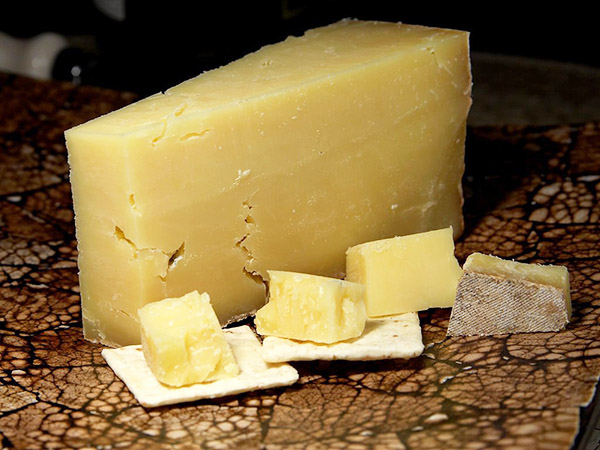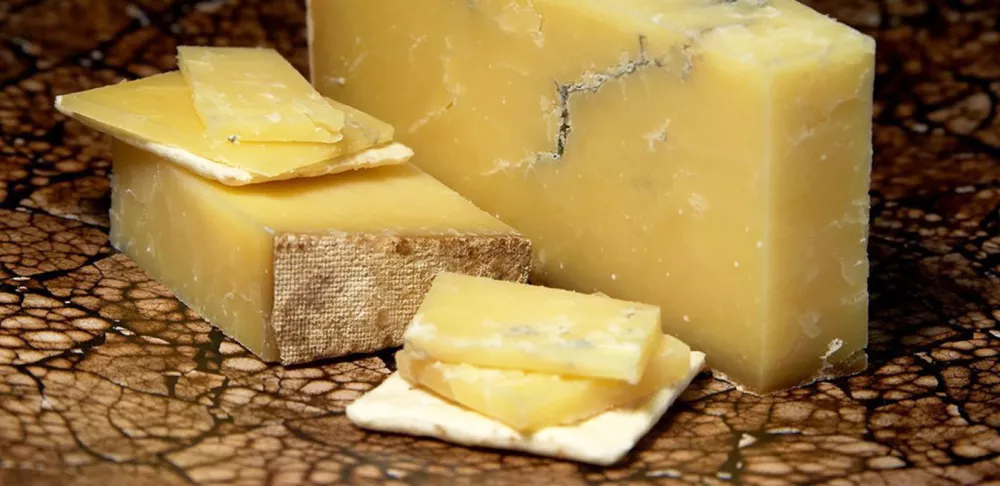Cheddar cheese is the second-most consumed cheese in the U.S., just behind mozzarella.
Despite it being our go-to cheese for nachos, burgers, grilled cheeses and homemade cheddar cheese sauce for mac n' cheese — or that which we often add to béchamel to make mornay sauce — what do we really know about its history, process and application?
Cheddar is a lot more complex than the orange blocks which are sold in vacuum-sealed packages or as bags of shreds, but those are typically the forms in which most of us in this country are introduced to cheddar. To start, cheddar cheese has over 1,000 years of history behind it, making it one of the world’s oldest recognized cheese styles.
As chefs, we can no longer rely on just a cursory understanding of cheddar, given its popularity. So now it’s time to really get to know cheddar: the how, what, where and why of one of the world’s most beloved cheeses.
Here are five things you should know about cheddar:
1. Cheddar Is a Place
Like many cheeses with European origins, cheddar cheese is named for the town in which it was born. Cheddar is a village in Southwest England’s Somerset County, where the style that we’ve come to know as cheddar originated.
Unlike many European cheeses that are named for their geographic origin, however, cheddar does not have PDO, or “protected designation of origin” status, even within England, meaning the use of the word cheddar does not have any legal restrictions attached to it in terms of where, or really even how, it is made. Cheddar is traditionally made from cow’s milk, for example, but there are several “goat cheddars” on the market as well.
This certainly adds to our confusion about what cheddar is, since the springy, bright orange blocks we buy in the grocery store qualify as cheddar just as much as savory, artisanal wheels of less intense color, crumblier texture, and which may be bandaged with cheesecloth, coated with wax or have a natural rind.
Read More: Understanding Cheese Rinds >
2. Cheddar Is Also a Verb
Much in the way that brand names like Xerox became a verb over time to describe its respective functionality, “cheddaring” is also a term to describe a process in the making of cheddar cheese.
While there aren’t a lot of rules governing the making of cheddar, many artisanal cheddars still adhere to a process of cutting and shaping the curds in a way that is particular to cheddar. Most firmer cheeses are “pressed,” meaning that once the curds have been separated from the whey and drained, they are placed in a mold and pressed to form a mostly homogenous texture within the wheel or block of cheese. Cheddars include a step whereby the curds are salted, kneaded and stacked before pressing, resulting in tiny fissures throughout the cheese that remain while it ages, and contribute to its crumbly texture.
Cheddars may also develop slight blue veining in these fissures, which gives those particular cheddars character, and is not an indicator of spoilage in the cheese.
3. Cheddar Isn't Your Best Melter (Say What Now?)
This may seem counterintuitive, (and perhaps nearly sacrilege) given the numerous ways we use cheddar in melted formats, but you may notice that both with block and artisanal cheddars, they can become a little greasy when heated. This has to do with the structure of how the cheese is made: Pressed cheeses are either “cooked” or “uncooked,” referring to whether the curds are heated before being pressed into a mold.
Cheeses whose curds are “cooked” undergo a structural change whereby the protein and fat molecules bind together and become homogenized, which makes these kinds of cheeses excellent melters. (The Gruyère atop your French onion soup is a good example.)
Cheddar cheeses are “uncooked” before pressing, meaning the fat tends to leak out of the cheese when heat is applied for the first time. This can be adjusted, however, by mixing cheddar with other “cooked” cheeses in preparations such as grilled cheese or mac and cheese, or incorporating cheddar into a béchamel sauce.

4. Yellow Cheddar Began as a Fraud
While animal milks do have a slight spectrum of various colors based on their species and diet, no animals are known to have milk that is naturally the color of Cheetos. Likewise, some cheeses may intensify in color as they age, but the bright orange of certain cheddars comes from a coloring agent, not time.
The legend of orange cheddar has to do with certain cheesemakers trying to pass off lesser quality cheddars as higher quality ones, and there are several mythologies as to when and who started this. The simplest explanation was that the addition of annatto seed, which is still used today for orange cheeses such as cheddar and Mimolette, was introduced as a point of differentiation for one Somerset cheesemaker, who simply wanted to draw attention to his cheeses in a locale where everyone was all making the same kind of cheese.
Another mythology was that certain cheesemakers were stripping the fat from their batches of milk in order to diversify their production: using the fat for butter and the skimmed milk for cheese, and the addition of annatto or another colorant gave the false impression of a richer cheese that hadn’t been reduced of its butterfat.
5. Sharpness In Cheddar Is Not a Measure of Strength
When English cheddars got imported to the U.S. in the 19th century, the usage of the word “sharp” as applied to cheese got imported along with them, and then almost immediately misused.
While sharpness in cheddar is linked to age, and age does tend to strengthen the flavor of cheddar as water content evaporates and flavor compounds concentrate, sharpness is a measure of the resulting acidity, not flavor. It is more accurately a measure of tang, not aromatics. (As someone who instructs at a cheese shop, people often use the word “sharp” to apply to cheeses other than cheddars to mean “strong,” often in smell, which isn’t the same thing.)
There are also no legal parameters in terms of how much aging is required to label cheddars as medium, sharp, extra sharp, etc., and whether those cheddars are aged in a vacuum seal or an open air cave, so it’s up to individual cheesemakers in terms of what age ranges they want to set for those particular labels for their cheese. So one cheesemaker’s extra sharp cheddar cheese might not have the same impact as another’s.
Cheddar Cheeses to Try:
Though several brands of vacuum-sealed cheddars get high marks for quality, you can really get to know cheddar cheese better by seeking out artisanal cheeses made by cheesemakers in your local area at farmers’ markets, a specialty cheese retailer or even Whole Foods. (I’ll even give Trader Joe’s Unexpected Cheddar a thumbs up, which is a worthy mixed cow and goat’s milk cheddar.)
Meanwhile, here are several artisanal cheddars with relatively wide distribution that are worth your attention:
Neal’s Yard Dairy Montgomery’s Cheddar
Milton Creamery Flory’s Truckle
Cellars at Jasper Hill Cabot Clothbound Cheddar
Bleu Mont Dairy Bandaged Cheddar
Grafton Village 1 Year Cheddar
Murray’s Cave Aged Original Stockinghall Cheddar
Beecher’s Flagship Handmade Cheese
More Cheese, Please: 5 Major Cheese Styles Every Chef Should Know >






